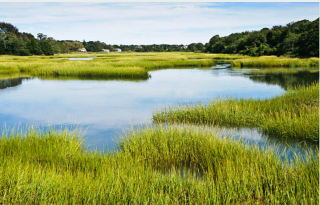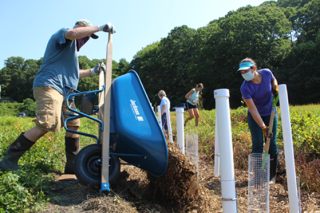EPA Research in Massachusetts

EPA researchers are working hard to protect communities across the nation. Learn about some of the work EPA researchers are doing in Massachusetts.
- Helping Coastal Communities Address Beach Closures
- Managing Bays and Estuaries
- EPA Scientists Study the Carbon-Storing Power of Seagrass to Fight Climate Change
- How EPA Researchers are Reframing Approaches to Coastal Climate Adaptation Efforts
- Tackling Cape Cod’s Nutrient Pollution and Protect Water Quality
- EPA Scientists Develop Method for Estimating Recreational Visitors and Value of Cape Cod Estuaries
- Cleaning Up a Subway Contaminated with Anthrax
- Determining Extent of Contaminant Impacts to Groundwater
- Approaches for Reducing Excess Nutrients Entering Cape Cod's Coastal Waters
- Helping Cities Measure Their Resilience
- The Cyanobacteria Assessment Network
For more EPA work, see EPA in Massachusetts.
Helping Coastal Communities Address Beach Closures
Tourism and recreation are critical to the economy and communities of Cape Cod, Massachusetts. An EPA study found that when popular Cape Cod beaches are closed for the day due to bacteria levels in the water, it can mean losses of more than $15,000 for the community. EPA researchers are currently conducting a survey across New England to learn about other issues that affect people’s decision to go to the beach and to understand how water quality impacts these communities. Read Helping Coastal Communities Address Beach Closures.
Managing Bays and Estuaries
Massachusetts has 47 independent embayments—harbors, bays, and coves—that make up the coastline, each with different watershed, landscape, and ecosystem benefit characteristics to meet those targets. EPA scientists in the Office of Research and Development are working with MassBays on the many benefits, including economic, that come from these natural resources, as well as the issues that may threaten them.
EPA Scientists Study the Carbon-Storing Power of Seagrass to Fight Climate Change
Seagrass meadows make up a powerful carbon storage system—one that, if properly managed, could help rein in global carbon dioxide emissions responsible for climate change. To get a better picture of how much carbon is stored in seagrass meadows, EPA researchers in New England sampled seagrass and sediments from 11 meadows in the region. Read EPA Scientists Study the Carbon-Storing Power of Seagrass to Fight Climate Change.
How EPA Researchers are Reframing Approaches to Coastal Climate Adaptation Efforts

Coastal areas and salt marshes are becoming increasingly vulnerable from land- and climate-based stressors such as accelerated sea level rise, droughts, flooding, and increased land development. To help protect these areas, EPA scientists evaluated both the scientific methodology and management practices behind coastal restoration projects. Using this research, they developed a framework to assist communities with collaboratively managing these fragile ecosystems. Read “Marshing Forward” Despite Uncertainty: How EPA Researchers are Reframing Approaches to Coastal Climate Adaptation Efforts.
How EPA Researchers Use Social Science to Study the Human Dimensions of Water Quality in New England
Coasts and estuaries provide important resources for communities. To help protect these areas, EPA researchers are using social science to study the value that people place on water quality in coastal environments. This work allows environmental managers, decision makers, and individual community members to better understand the value of investing resources into water quality improvements and protection of natural environments. Read Determining the Value of Clean Water: How EPA Researchers are using Social Science to Study the Human Dimensions of Water Quality in New England.

Tackling Cape Cod’s Nutrient Pollution and Protect Water Quality
Like many places in the country, Cape Cod’s coastal waters are under stress from excess nutrients. EPA researchers are collaborating with federal, state, and community partners with the common goal of restoring the water quality and natural ecosystems on which the region depends. Read EPA Scientists and Partners Team Up to Tackle Cape Cod’s Nutrient Pollution and Protect Water Quality.
EPA Scientists Develop Method for Estimating Recreational Visitors and Value of Cape Cod Estuaries
Many people travel to Cape Cod for its beaches, but smaller coastal areas, such as estuaries, are also valued by visitors and residents. EPA researchers developed a new method to study the number of visitors to Cape Cod’s estuaries. Understanding the social and economic value of recreation for an estuary provides beach managers with insight into the benefits of investing resources in recovering an estuarine area. Read EPA Scientists Develop Method for Estimating Recreational Visitors and Value of Cape Cod Estuaries.
Cleaning Up a Subway Contaminated with Anthrax

EPA's Office of Research and Development is a leader in improving the nation’s ability to cleanup buildings contaminated with anthrax or other biological agents. In recognition of the complexities that would be involved, and the number of cities that have underground rail system, EPA along with Department of Homeland Security, Department of Defense and several national laboratories turned their attention to the cleanup of subway systems contaminated with anthrax. At Fort A.P. Hill, researchers evaluated decontamination technologies that could be used in the event of an anthrax incident in a subway system.
Determining Extent of Contaminant Impacts to Groundwater
The former Fort Devens had an onsite landfill for solid waste generated during several decades of operations, resulting in contaminated groundwater that has impacted an adjacent recreational lake (Plow Shop Pond) and the aquifer underlying the Town of Ayer, Massachusetts. EPA Office of Research and Development, in collaboration with Region 1 and the U.S. Army, implemented a monitoring program to clearly define the location and nature of impact to Plow Shop Pond. Confirmation that the landfill was the source of contamination led to construction of a hydraulic barrier wall to prevent plume discharge to the lake and removal of contaminated sediments.
Approaches for Reducing Excess Nutrients Entering Cape Cod's Coastal Waters
Excess nutrients from human activities are an increasingly serious threat to water resources as they degrade water quality and contribute to algae blooms, low dissolved oxygen, loss of habitat and species diversity and, in extreme cases, fish kills. EPA, in collaboration with U.S. Geological Services, is partnering with Barnstable Clean Water Coalition, the Massachusetts Alternative Septic System Test Center, Massachusetts Department of Environmental Protection, and the Town of Barnstable to implement a neighborhood-scale demonstration of enhanced innovative alternative septic systems.
Helping Cities Measure Their Resilience
EPA researchers looked at vulnerabilities to environmental changes in Washington, District of Columbia, and Worcester, Massachusetts. Their report describes a comprehensive and flexible workbook that cities can use to become more resilient to these changes. Read EPA Researchers are Helping Cities Measure Their Resilience.
The Cyanobacteria Assessment Network
The Cyanobacteria Assessment Network uses historical and current satellite data to provide an early warning for harmful algal blooms in freshwater. Since 2015, CyAN imagery has detected algal blooms in Ohio, Florida, California, Vermont, New Hampshire, Massachusetts, Connecticut, and Rhode Island before traditional monitoring efforts alerted watershed managers. Read The Cyanobacteria Assessment Network.
